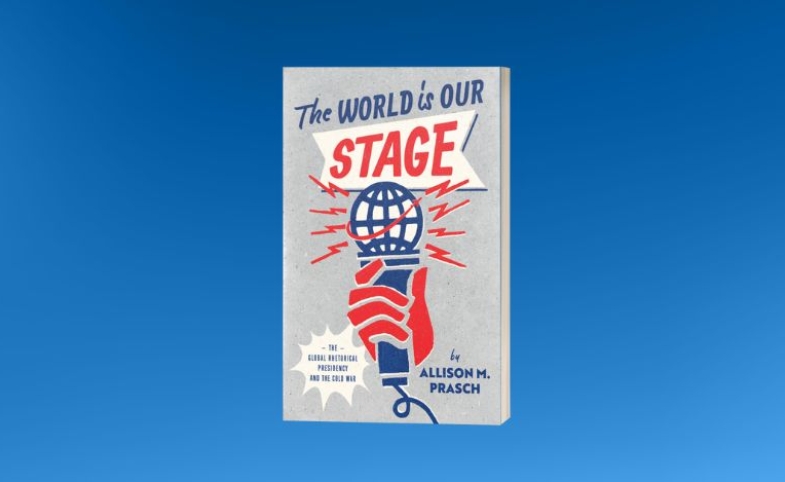Note from the CPD Blog Manager: This excerpt from Moira Whelan's piece originally appeared in the 2017 Soft Power 30 report. Click here to read the full article. An American president’s first trip is always...
KEEP READINGThe CPD Blog is intended to stimulate dialog among scholars and practitioners from around the world in the public diplomacy sphere. The opinions represented here are the authors' own and do not necessarily reflect CPD's views. For blogger guidelines, click here.

A Review of The World is Our Stage: The Rhetorical Presidency and the Cold War
Note from the CPD Blog Manager: This piece is a review of the book The World is Our Stage: The Rhetorical Presidency and the Cold War by Allison M. Prasch.
As a young fan of classical music one of my favorite types of records was collections of overtures from one composer: Rossini, Verdi, Wagner and so forth. As the overtures were written as introductions to larger works they made a great gateway to each composer’s wider output, inviting deeper exploration of larger, longer works when opportunity allowed. Allison M. Prasch’s excellent new book The World is Our Stage: The Rhetorical Presidency and the Cold War, contributes to the literature of public diplomacy in a similar way. It is enjoyable and fresh in its approach, but by focusing on the overtures and preludes – in her case, single set-piece overseas appearances by Cold War presidents – Prasch highlights an entire tradition. The result is more accessible than the treatments of public diplomacy that tackle an entire administration’s overseas rhetoric like Greg Tomlin’s terrific book on Kennedy-era public diplomacy or attempts to tell the story of a rhetorically focused agency like USIA from inception to close, as I attempted to do.
The book shows specifically how archival materials created with the United States Information Agency (USIA), which have been frequently neglected, can illuminate the great moments of US foreign policy.
Prasch opens her book by establishing her notion of the global rhetorical presidency in which presidents seek to provide domestic and international leadership through stage-managed visits to key foreign locations. The tradition begins with Theodore Roosevelt’s trip to Panama in 1906 and continues with Woodrow Wilson at Versailles in 1919 but is perfected by Franklin D. Roosevelt’s Good Neighbor diplomacy or the 1930s and wartime summitry. Her five cases are all eloquent examples of the way in which successive presidents refined and mobilized the genre of international visit/speech to deliver on foreign policy objectives. Her cases are Truman in Potsdam; Eisenhower’s second term goodwill visits; Kennedy in Berlin; Nixon in China and Reagan’s bravura performance in Normandy at the 40th anniversary of D-Day in 1984.
Each of these cases is vividly described with attention both to context and the development and delivery of core messages. A deep dive into the archives has furnished multiple insights as to how particular highpoints came to be. Of particular value is her account of the development of Kennedy’s Ich bin ein Berliner speech, which she demonstrates was carefully planned before his trip of June 1963, and her close analysis of Reagan’s remarks in Normandy. She shows that his acknowledgment of Soviet wartime sacrifice was a late but highly significant addition. There is a reason he was known as "the great communicator."
The book shows specifically how archival materials created with the United States Information Agency (USIA), which have been frequently neglected, can illuminate the great moments of U.S. foreign policy. Fascinating moments include the crisis in Japan in 1960 during which riots forced Eisenhower to abandon his plan to visit and USIA’s evidence of the astonishing success of Nixon’s visit to China which USIA polling revealed to be as impactful as the Soviet’s launch of Sputnik. Archive materials originating in other agencies include an intelligence estimate that compares Nixon’s arrival in Beijing to that of the Manchu warriors invited by the Ming emperor to drive off barbarians, only to stay and become the next dynasty. In the presumed CIA man’s analogy, the Soviet Union maps to the barbarians and the US or its capitalist philosophy is the next dynasty. Seen in retrospect, the document is a reminder of how unperceptive, reductionist, and crudely imperialist the US foreign policy machine can be.
It would be interesting to know whether LBJ, Ford or Carter had any moments in which Prasch considered giving the full "rhetorical presidency" treatment. Carter’s speech in Tehran affirming the Shah perhaps serves as the opposite of her highpoints, showing how a president can undermine their moral leadership and Reputational Security with misplaced public complements. Her conclusion deftly shows that the story continues with telling vignettes of Clinton, Obama, and Trump in action all of which beg a sequel volume by Prasch when declassification allows. In the meantime, we have a terrific and thought-provoking book that deserves to be on Cold War public diplomacy reading lists and in the hands of anyone trying to understand the symbolic and rhetorical aspects of US foreign policy past and present which – in this era of TikTok and the platform formerly known as Twitter – is a lot of people.
Visit CPD's Online Library
Explore CPD's vast online database featuring the latest books, articles, speeches and information on international organizations dedicated to public diplomacy.
POPULAR ARTICLES
-
March 22
-
April 11
-
April 1
-
March 4
-
March 19
Join the Conversation
Interested in contributing to the CPD Blog? We welcome your posts. Read our guidelines and find out how you can submit blogs and photo essays >.













